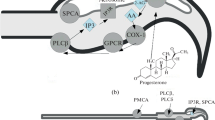Summary
In ascidians, sperm activation is characterized by the morphologically distinctive process of mitochondrial translocation. This process is known to be driven by actin:myosin interactions. We have studied mitochondrial translocation in sperm cells of Ascidia ceratodes and found it to be dependent on internal calcium release as well as external calcium entry. Here we show that (1) internal release is dependent upon the action of inositol 1,4,5-trisphosphate produced by G protein-dependent activation of a phospholipase Cβ, and (2) the rise in internal calcium ion concentration that results is linked to redistribution of protein kinase C from cytosolic sites to membranous sites where it triggers the signal transduction steps leading to mitochondrial translocation.
Access this chapter
Tax calculation will be finalised at checkout
Purchases are for personal use only
Preview
Unable to display preview. Download preview PDF.
Similar content being viewed by others
References
Butler DM, Allen KM, Garrett FE, Lauzon LL, Lotfizadeh A, Koch RA (1999) Release of Ca2+ from intracellular stores and entry of extracellular Ca2+ are involved in sea squirt sperm activation. Dev Biol 215:454–464
Downey JC, Lambert CC (1994) Attachment of the ascidian sperm surface egg receptor N-acetylglucosamine to the cell membrane. Mol Reprod Dev 38:453–458
Garrett FE, Goel S, Yasul J, Koch RA (1999) Liposomes fuse with sperm cells and induce activation by delivery of impermeant agents. Biochim Biophys Acta 1417:77–88
Higashijima T, Uzu S, Nakajima T, Ross EM (1988) Mastoparan, a peptide toxin from wasp venom, mimics receptors by activating GTP-binding regulatory proteins (G proteins). J Biol Chem 263:6491–6494
Koch RA, Norton ML, Vazquez H, Lambert CC (1994) Sperm-surface chymotrypsin-like protease activity required for fertilization in ascidians. Dev Biol 162:438–450
Lambert CC (1986) Fertilization-induced modification of chorion N-acetylglucosamine groups in the ascidian chorion, decreasing sperm binding and polyspermy. Dev Biol 116:168–173
Lambert CC (1989) Ascidian sperm penetration and the translocation of a cell surface glycosidase. J Exp Zool 249:308–315
Lambert CC, Epel D (1979) Calcium-mediated mitochondrial movement in ascidian sperm during fertilization. Dev Biol 69:296–304
Lambert CC, Lambert G (1984) The role of actin and myosin in ascidian sperm mitochondrial translocation. Dev Biol 106:307–314
Lax Y, Rubinstein S, Breitbart H (1997) Subcellular distribution of protein kinase C alpha and betal in bovine spermatozoa, and their regulation by calcium and phorbol esters. Biol Reprod 56:454–459
Li M, Jiao R, Sun Q, Hu G, Duan C, Liu H, Song X, Chen, D (1996) Signal transduction pathways in guinea pig sperm. Sci China C Life Sci 39:484–490
Taylor SJ, Chae HZ, Rhee SG, Exton JH (1991) Activation of the pi isozyme of phospholipase C by a subunits of the Gq class of G proteins. Nature 350:516–518
Tosti E, Palumbo A, Dale B (1993) Inositol tri-phosphate in human and ascidian spermatozoa. Mol Reprod Dev 35:52–56
Walensky LD, Synder SH (1995) Inositol 1,4,5-trisphosphate receptors selectively localized to the acrosomes of mammalian sperm. J Cell Biol 130:857–869
Zhang Z, Baker HW (1997) The effect of 12-myristate 13-acetate phorbol ester on human sperm hyperactivation. Fertil Steril 67:1140–1145
Author information
Authors and Affiliations
Corresponding author
Editor information
Editors and Affiliations
Rights and permissions
Copyright information
© 2001 Springer Japan
About this chapter
Cite this chapter
Koch, R.A., Allen, K., Kim, J., Lotfizadeh, A. (2001). Cell Signaling in Ascidian Sperm: Upstream and Downstream of Internal Calcium Release. In: Sawada, H., Yokosawa, H., Lambert, C.C. (eds) The Biology of Ascidians. Springer, Tokyo. https://doi.org/10.1007/978-4-431-66982-1_6
Download citation
DOI: https://doi.org/10.1007/978-4-431-66982-1_6
Publisher Name: Springer, Tokyo
Print ISBN: 978-4-431-66984-5
Online ISBN: 978-4-431-66982-1
eBook Packages: Springer Book Archive




